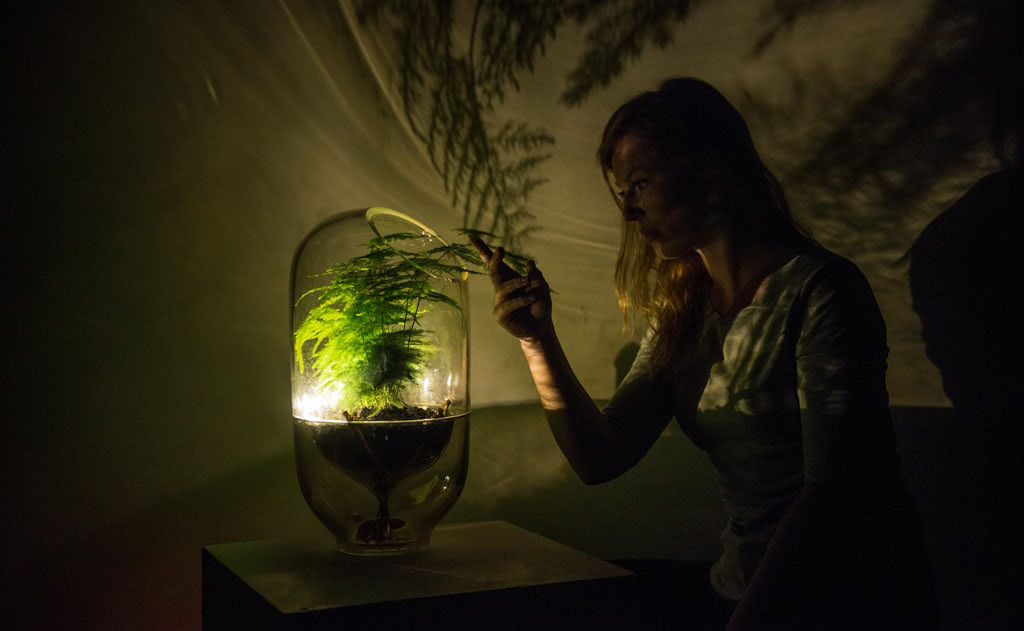Do you sometimes wish your lighting was a bit more lively? Or even alive? The Living Light is no ordinary lamp. A unique design project, it harnesses the energy of living plants to provide light. We spoke to Ermi van Oers, designer of the unusual product, to find out more about the Living Light, the philosophy behind it and the team's plans for the future
Putting plant energy to work
Over the last few years, with the open question of how we power our future looming, a lot of new energy sources have come into focus. We're exploring solar power, hydro-power and wind-power, among others. How does plant power fit into this? "We need green energy" says van Oers, "but the sun doesn't always shine and the wind doesn't always blow. Plants can provide energy 24/7".
The inspiration for the Living Light, she says, came from the realization of how many potentially useful resources are wasted every day. Van Oers studied product design at Rotterdam's Willem de Kooning Academy and says that while learning about bio-design she noticed "the resources that go to waste every day can have so many different uses if we harness them".
So how does the Living Light actually work? It's based on a new technology called microbial fuel cells. "The microbial fuel cell harvests energy from the breakdown of organic compounds" van Oers explains. "These compounds are naturally released by plants all the time, and all we need to do is use these fuel cells to put that spare energy to work".

Because of the way this process draws on a byproduct of the plant's waste processes, it also works better the more you care for the plant fuelling the Living Light. The healthier the plant, the more organic compounds it ultimately secretes as waste, and it's the electrons released as these compounds break down that allow the microbial fuel cell to work.
Van Oers thinks this nurturing element could get users to rethink their relationship with both nature and technology. If your lamp stops working now, you're not likely to feel anything but annoyance and inconvenience. But if you notice your Living Light beginning to dim, the reaction is very different. "You think, is the plant doing okay? Does it need more water?".
The planned Living Park project aims to forge this human connection with nature on a larger scale. The idea is to have plant-fuelled lights in the park to react to visitors walking past, creating a magical feeling of direct connection with nature. "What happens under the soil is magical. I want to make the invisible visible, and connect people with the natural processes already going on beneath their feet".

The future of the Living Light
For van Oers, all of this is fuelled by an ethos of cross-pollination between science, technology and design. "I'm a designer, not a scientist, but it's incredibly valuable to be able to work together across disciplines. We speak totally different languages, but when we can bridge that gap, we have a symbiotic relationship".
During our conversation, van Oers is keen to emphasize the collaborative nature of the project. She works together not only with a team of designers and developers, but in partnership with Plant-e, the creators of the microbial fuel cell technology.
Having started out life as van Oers' graduation project, the Living Light enters a limited production run soon. The product won't be available until April, but on the Living Light website it's already possible to pre-order yours and subscribe to the newsletter to keep up to date.
Where does the project go long-term? "For now" van Oers says, "the Living Light is more of a proof of concept. It's a storytelling object, and expensive to make, but the goal is to inspire people about the possibilities for using this technology on a larger scale".
She is optimistic about the Living Light's potential to scale up. "I really hope that for future generations, this usage of plant energy is just taken for granted as something normal. This spare fuel is already waiting for us; why wouldn't we use it?".


Comments (0)
Share your thoughts and join the technology debate!
No comments yet
Be the first to share your thoughts!